The term “cyberpunk” is a fiercely contested genre label, caught somewhere between the retro-worshipping fetishists of the jack-in age and the far-flung promise (or threat) of a future that can solve all of humanity’s current problems with imminent tech. The denizens of each are as varied and debated as the cityscape itself—some are stereotypes, living within labels bought from the society that feeds them, while others are renegades living life the way they want to. With or without permission.
Ultimately, the women of the cyberpunk genre are put through a Voight-Kampff litmus test of “if/then/else” that always seems intent to force her into a box of some easily prepared label. Her responses to the subjects around her, scenes she is in and stimuli she experiences are scrutinized, measured and debated until a verdict within the self is reached: yes, Virginia, this woman is a replicant. But then, aren’t we all?
Fortunately, one of the things cyberpunk does best is skew expectation, force characters to adapt (or die!), and get good. I’ve got five badass cyberpunk women who are experts at rolling with the punches. And who aren’t replicants.
As far as you know.
Michelle from The Gene Generation (film, 2007) / The DNA Hacker Chronicles by
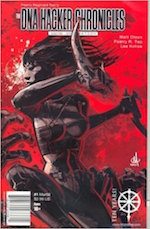 In a futuristic world, DNA hackers are hunted down and removed by specially trained assassins. Michelle is one such badass, taking on grim bloody work to get herself and her trouble-magnet, family-hungry brother out of this place and somewhere safer. The comic series inspired the movie, was directed by the same fellow who wrote the comics, and intentionally brings out that comic over-the-top feel. That visual commentary was lost on some moviegoers, who commented more on Bai Ling’s push-up apparel and long legs than her sheer epic capability and unique sense of self. “Bai Ling does her best—she fills out her sexy costume and strips down for a couple of nude scenes,” said one commenter on Rotten Tomatoes, as if “her best” is limited only to what she looks like. An observation repeated on IMDB: “Oh, she[sic] easy on the eyes, especially when she did nude scenes. But her thick accent is distracting.” All the usual fixation on what a heroine looks like, how she soothes or offends expectations, how she isn’t perfect. But I see her for what she is: a woman who wears what she wants, doesn’t care what people say about her, a world-class assassin who is also human—working her ass off at a hard, dangerous job for her family. For a dream. Does this make her sub-human? Too girly? Too tough to be a romantic lead? Too Other? I don’t think so. I look around me and I see so many women in this modern world that do that and more for family; shedding blood, sweat and tears for the ones they love, with spines of steel and the emotional maturity to be more than a badass, more than an antihero or programmed robot. Michelle may have an artisan push-up bustier, but she wears it while kicking ass in the name of family. I can get behind that.
In a futuristic world, DNA hackers are hunted down and removed by specially trained assassins. Michelle is one such badass, taking on grim bloody work to get herself and her trouble-magnet, family-hungry brother out of this place and somewhere safer. The comic series inspired the movie, was directed by the same fellow who wrote the comics, and intentionally brings out that comic over-the-top feel. That visual commentary was lost on some moviegoers, who commented more on Bai Ling’s push-up apparel and long legs than her sheer epic capability and unique sense of self. “Bai Ling does her best—she fills out her sexy costume and strips down for a couple of nude scenes,” said one commenter on Rotten Tomatoes, as if “her best” is limited only to what she looks like. An observation repeated on IMDB: “Oh, she[sic] easy on the eyes, especially when she did nude scenes. But her thick accent is distracting.” All the usual fixation on what a heroine looks like, how she soothes or offends expectations, how she isn’t perfect. But I see her for what she is: a woman who wears what she wants, doesn’t care what people say about her, a world-class assassin who is also human—working her ass off at a hard, dangerous job for her family. For a dream. Does this make her sub-human? Too girly? Too tough to be a romantic lead? Too Other? I don’t think so. I look around me and I see so many women in this modern world that do that and more for family; shedding blood, sweat and tears for the ones they love, with spines of steel and the emotional maturity to be more than a badass, more than an antihero or programmed robot. Michelle may have an artisan push-up bustier, but she wears it while kicking ass in the name of family. I can get behind that.
Rhye from “And You Shall Knew Her by the Trail of Dead” by Brooke Bolander
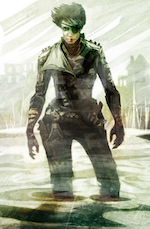
Listen, if you haven’t met Rhye, I don’t know what to say to you. In this Nebula-nominated story, Bolander introduces a woman so messed up, so hard, so balls-nailed-to-the-wall badass that any litmus test anyone tries to slap on her will roll them in the same place—rotting in a gutter. Rhye is foul-mouthed, aggressive, hot-tempered, fueled by the spite and vitriol that shapes a culture ground down by the privileged favored, and for all that, she’s hit rock bottom and iron-fisted her way back to something no one else would call good living. But it is. Because this is the life she exists in, the world she brutalizes into making room for her, and no one and nothing will stop her from taking what she wants. It might not be everyone’s drug of choice, but that’s the point. Rhye doesn’t give a damn if people think she’s lippy or unfeminine or bitchy or rude. If someone in Rhye’s way has a problem with it, they’d better prep to pay up—and Rhye don’t take credit. Her time is hers. Bolander may not be writing about every woman, everywhere, but I can say for a fact that there are women out there who see themselves reflected in Rhye’s eyes and say to themselves, “Oh, hell, yes.” I want Rhye at my back. And you can bet I’d have hers. The world needs more warrior women willing to push beyond every last iota of will and come back hungry for more.
Violet Song Jat Shariff from Ultraviolet (film, 2006) by Kurt Wimmer
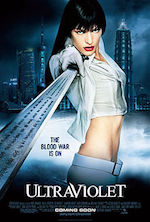 Oh, yeah. I’m going here. Milla Jovovich, and by default the whole movie, got widely panned by critics in part because of the generally glamorous take on cyberpunk. Instead of black vinyl and grit, we saw cyberpunk that was something more than just pretty—it was viciously on fleek, colorful and vibrant while dangerous as a razor blade. The movie is slick, the world highly futuristic, (the plot, as always, is made to entertain) yet the improbability of a badass woman who looks great in colorful gear and has awesome hair and great make-up is somehow a minus in critical reviews. It’s one of the reasons I love Violet—because glam is as much a part of cyberpunk as street filth and blood, the Jem and the Holograms to the Rob Zombies of the futuristic world. She rocks it so confidently, so effortlessly, providing a role model for women who want to be badass and look freaking awesome doing it. (Also, anyone who thinks it’s for “girls only” may want to research how to pull a chrome stiletto out of one’s eye socket.) Jovovich’s Violet doesn’t let others make her decisions—and she is surrounded by authoritarian men who try. Instead, she obeys her gut, shows empathy without compromising herself for it, and has zero trouble storming a corporate fortress to right a wrong. And that, my friends, takes guts. If she happens to look hella awesome while doing it, that’s just frosting.
Oh, yeah. I’m going here. Milla Jovovich, and by default the whole movie, got widely panned by critics in part because of the generally glamorous take on cyberpunk. Instead of black vinyl and grit, we saw cyberpunk that was something more than just pretty—it was viciously on fleek, colorful and vibrant while dangerous as a razor blade. The movie is slick, the world highly futuristic, (the plot, as always, is made to entertain) yet the improbability of a badass woman who looks great in colorful gear and has awesome hair and great make-up is somehow a minus in critical reviews. It’s one of the reasons I love Violet—because glam is as much a part of cyberpunk as street filth and blood, the Jem and the Holograms to the Rob Zombies of the futuristic world. She rocks it so confidently, so effortlessly, providing a role model for women who want to be badass and look freaking awesome doing it. (Also, anyone who thinks it’s for “girls only” may want to research how to pull a chrome stiletto out of one’s eye socket.) Jovovich’s Violet doesn’t let others make her decisions—and she is surrounded by authoritarian men who try. Instead, she obeys her gut, shows empathy without compromising herself for it, and has zero trouble storming a corporate fortress to right a wrong. And that, my friends, takes guts. If she happens to look hella awesome while doing it, that’s just frosting.
Dectective Newton, Dante Street Precinct from Transmetropolitan by Warren Ellis
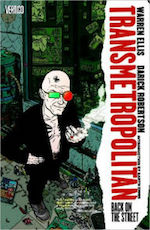 Do you remember Detective Newton? Did you pause at all while devouring the rotgut that is Ellis’ take on a world rapidly becoming ours to witness the beauty, the fury, the determination, the iron-bending heart in this detective? With a badge light-tattoo on her cheek and a world of bloody anguish in her eyes as she warns Spider Jerusalem away from a situation compromised by a nasty little case of “the blue flu,” this badass woman is the very model of a cop I want protecting my future streets. So loyal she stands her post even though she knows what’s coming, so filled with duty that it kills her to know she and her fellow officers are just pawns in a political set-up, and yet, willing to let Spider shoot her with a bowel-buster because it’s the only way he’ll get through the thin blue line and do what she has been kept from doing. She is loyalty and fierce pride in the badge, stalwart and dedicated, and pleased as freaking punch when she finally gets to nail the political rat that put innocent civilians in such bloody harm. She’s the kind of cop who can growl “not on my watch!” and mean every syllable. When I need help on the gritty cyberpunk streets, I got dibs on Detective Newton on my side. Full. Flat. Stop.
Do you remember Detective Newton? Did you pause at all while devouring the rotgut that is Ellis’ take on a world rapidly becoming ours to witness the beauty, the fury, the determination, the iron-bending heart in this detective? With a badge light-tattoo on her cheek and a world of bloody anguish in her eyes as she warns Spider Jerusalem away from a situation compromised by a nasty little case of “the blue flu,” this badass woman is the very model of a cop I want protecting my future streets. So loyal she stands her post even though she knows what’s coming, so filled with duty that it kills her to know she and her fellow officers are just pawns in a political set-up, and yet, willing to let Spider shoot her with a bowel-buster because it’s the only way he’ll get through the thin blue line and do what she has been kept from doing. She is loyalty and fierce pride in the badge, stalwart and dedicated, and pleased as freaking punch when she finally gets to nail the political rat that put innocent civilians in such bloody harm. She’s the kind of cop who can growl “not on my watch!” and mean every syllable. When I need help on the gritty cyberpunk streets, I got dibs on Detective Newton on my side. Full. Flat. Stop.
Deunan Kneute from Appleseed by Masamune Shirow
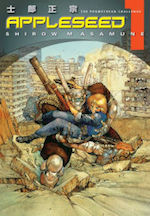 Appleseed is debatably cyberpunk, but when you think about cyberpunk as an umbrella term, it fits right in. Deunan is one of my favorite heroines, her world nothing but war until she’s scooped up and brought to Utopia—a city where things may be just too good to be true. It’s a high-tech, high-action look at the reach for perfection, and what it takes to preserve it…or destroy it. One of the things I love about this one is that she’s at home in military cargoes and strapped to the hilt with firepower, but when given the chance, she’ll roll out in a miniskirt and heels with all the attitude of a woman comfortable in her own skin. Not only that, but she’s as capable a fighter in one as she is the other—and trust me, I can sprint in high heels. It is possible. (Recommended? No. But that’s what sets her apart.) And frankly, that’s incredible, to swing from one world to the next and embrace the life in either. Deunan has so much spirit, empathy colored by her years at war, a cocksure attitude and a fiercely competitive streak that plays out in her combat methods. She is fearless, loyal, competent as hell, and even better, she’s willing to hear others out, to be wrong, and to adapt. Badass and kind, hardened but warm, cocky but friendly. Like real people are, she’s complex and layered and I’d like to be her friend. Deunan does not care what the world at large thinks of her; she knows who she is, and who she wants to be.
Appleseed is debatably cyberpunk, but when you think about cyberpunk as an umbrella term, it fits right in. Deunan is one of my favorite heroines, her world nothing but war until she’s scooped up and brought to Utopia—a city where things may be just too good to be true. It’s a high-tech, high-action look at the reach for perfection, and what it takes to preserve it…or destroy it. One of the things I love about this one is that she’s at home in military cargoes and strapped to the hilt with firepower, but when given the chance, she’ll roll out in a miniskirt and heels with all the attitude of a woman comfortable in her own skin. Not only that, but she’s as capable a fighter in one as she is the other—and trust me, I can sprint in high heels. It is possible. (Recommended? No. But that’s what sets her apart.) And frankly, that’s incredible, to swing from one world to the next and embrace the life in either. Deunan has so much spirit, empathy colored by her years at war, a cocksure attitude and a fiercely competitive streak that plays out in her combat methods. She is fearless, loyal, competent as hell, and even better, she’s willing to hear others out, to be wrong, and to adapt. Badass and kind, hardened but warm, cocky but friendly. Like real people are, she’s complex and layered and I’d like to be her friend. Deunan does not care what the world at large thinks of her; she knows who she is, and who she wants to be.
We could all be so lucky to call any one of these women a friend. Heavens help us if we land on the wrong side of enemy.
K.C. Alexander is the author of Necrotech, an aggressive transhumanist sci-fi called “a tight, violent thrill ride in a fascinating cyberpunk world with one of the most interesting women protagonists I’ve read in a long time.” (Stephen Blackmoore, author of award-nominated Dead Things) Hit up kcalexander.com or haunt 140-character brain bytes at @kacealexander.










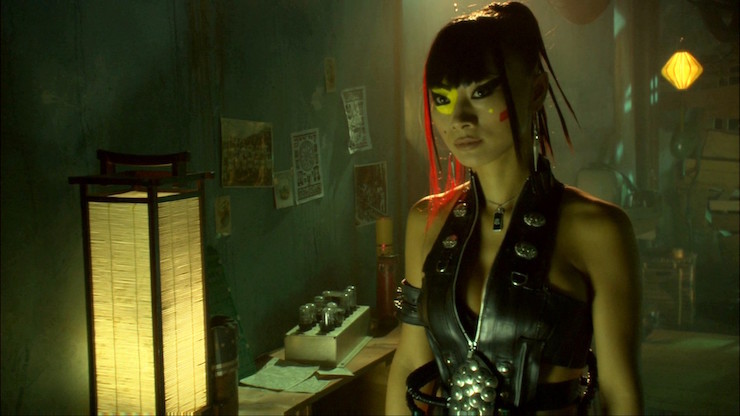
“….viciously on fleek”. I don’t usually like that word, but you kind of made it work :b
Really?
No Molly Millions?
Pat Cadigan’s Deadpan Allie (from Mindplayers) would also count.
What about the Major, Motoko Kusanagi from Ghost in the Shell: Stand-Alone Complex (or any of the other versions of the franchise). Basically the field-leader of Section Nine, the cybercrimes unit in the cyberpunk city of Niihama, she identifies as human (which is important in a world with fully-sapient AIs), but with synthetic everything –her organic body was destroyed when she was a child. She is both the best hacker and the best hand-to-hand fighter (or “cyberbody operator”) in the setting, and may even have moved completely beyond “human.”
Are you serious? No Molly Millions? Is this a joke?
I hope you’ve got a separate article queued up that’s all about Molly. Otherwise I’m not sure we can still be friends.
See above. Molly is the freaking bench mark.
I don’t usually read cyber-punk, but this commentary makes me want to dive in. K. C. has a way with words that brings out the excitement of these selections. She should be writing he tag lines on movie posters. I’ll have to check out her stuff. I also dig how she thinks bad-ass woman can still have a girly-girl side that doesn’t weaken her but instead makes her all the stronger.
Nope! No Molly Millions. I see some of you noticed the lack.
Why is Molly missing in this list? It goes like this: when one is writing an article about defying expectations, one starts by losing the expected. Molly, Major Motoko, and every Bladerunner reference are the top of everybody’s list no matter how many years have passed. In the same way that “we need more women in SF/F” is answered with “but we have Ursula K. LeGuin!” Yes, we do. We do have Molly and the Major, and we have had them for decades.
I don’t need to remind anyone that they exist, because we all know they do.
My goal here was to talk about other women who maybe aren’t in the genre eye already, women who have been panned or largely ignored despite being as badass as they are. Too girly, too small a role, too “Other”, too attractive—whatever the excuse, these badass cyberpunk women don’t get the cred they deserve.
Y’all have Molly and the Major covered. ;)
We all know them? Now I have to google who Molly Millions is.
Mila Jovovich’s character in Ultraviolet may have been a bad ass – it’s the reason I dragged my then-girlfriend-now-wife to see it (and Underworld in the same timeframe), and the director’s previous feature, Equilibrium was interesting enough, too…but …Ultraviolet was a genre Frankensteinian mess with 8-bit visuals in a post-Matrix world.I felt sorry for Mila and Bill Fichtner, whom I think is awesome always, for having to be part of that broken thing.
Seriously y’all? This list doesn’t say it is ALL the badass women. Or rank them. It’s just, hey here’s five badass women. What is wrong with you?
Also, if you have to Google Molly Millions, you’re probably in the wrong comment section.
Zoya from The Immortality Game. She starts as just a normal young Russian woman but becomes pretty badass by the end.
Does Friday count? I think she definitely would be on this list, but maybe her story isn’t really cyber-punky
@kacealexander—Good point. Thanks.
Sorry, kacealexander, but none of the protagonists you cite should be seen as “cyberpunk” heroines. Post-cyberpunk is a more apt label, since the term “cyberpunk” should be reserved for the 1980s literary movement which had John Shirley as its “godfather”, Bruce Sterling and William Gibson as its leaders, Pat Cadigan, Tom Maddox, Paul Di Filippo, Marc Laidlaw (who was one of the readers at this month’s KGB Fantastic Fiction reading series and with whom I had an excellent conversation about the early history of cyberpunk, noting how people ask me – “Who is Marc Laidlaw?” – when I mention cyberpunk’s literary history), Lewis Shiner, Walter Jon Williams, Richard Kadrey, Rudy Rucker and Greg Bear. (Others who wrote short stories and novels that could be viewed as cyberpunk include Michael Swanwick (“Vacuum Flowers”), Norman Spinrad (“Little Heroes”), and George Alec Effinger (“When Gravity Falls”, “A Fire in the Sun”, “The Exile Kiss). Since the early 1990s the only two novels I know of that come closest in emulating the cyberpunk literary movement are James Patrick Kelly’s “Wildlife” and Lauren Beukes’ “Moxyland”.
Any list of cyberpunk female heroines should include Gibson’s Molly Millions and Cadigan’s Deadpan Allie. It would also include Michael Swanwick’s Rebel Elizabeth Mudlark from “Vacuum Flowers”, Claire Rimpler from John Shirley’s “A Song Called Youth” (originally the “Eclipse Trilogy”), Laura Webster from Bruce Sterling’s “Islands in the Net”, and Janey Unger in Sterling’s “Heavy Weather”.
You may choose to academic any genre you like, John, however the widely understood genre is much, much wider than academia might be willing to accept. When I say “cyberpunk”, it reaches a large audience who are likely to swing between the narrowest of definitions and the widest of margins—which is, as they say, the point.
All genres are adaptive. All are growing. And I don’t ascribe to “only the old stuff or stuff that emulates the old stuff can ever be” way of life.
Also, cyberpunk includes many, many good books written by women these days. True story!
kacealexander,
If I were to use your analogy then, the Bloomsbury Group should not be viewed as consisting of only ten writers and artists, with the most notable ones being writers E. M. Forster and Virginia Woolf, economist John Maynard Keynes, painters Vanessa Bell, Roger Fry and Duncan Grant, and biographer Lytton Strachey. Like it or not, those who were part of the 1980s cyberpunk literary movement viewed the movement as consisting solely of themselves and maybe a handful of others, like Michael Swanwick (initially a cyberpunk until he declared himself as part of the “humanist” group led by John Kessel and James Patrick Kelly) and Lucius Shepard. In the interest of full disclosure, I’ve corresponded with John Shirley in the past regarding who was – and who wasn’t – a cyberpunk and Marc Laidlaw kindly gave me his own impressions when I met him Wednesday night that echoed what I heard from John Shirley.
I think you should respect their wishes and recognize that cyberpunk – strictly speaking – should be seen first and foremost as the 1980s literary movement in speculative fiction that arose from the Anglo-American New Wave, with writers as diverse as John Brunner, Samuel Delany, and Philip K. Dick anticipating some aspects of cyberpunk in their own works. Otherwise, to claim that cyberpunk should have an expansive definition results in lessening the importance of this group in shaping contemporary Anglo-American speculative fiction and offers ample confusion regarding what cyberpunk was and who its most important, most influential writers are.
kacealexander,
We could use as another example, the science fiction television-film phenomenon that is “Star Trek”. Purists – and that would include yours truly – will claim that the J. J. Adams reboot isn’t “Star Trek” since the characters and the plots are not consistent with Gene Roddenberry’s vision. Using your expansive definition of cyberpunk and having a similar view of “Star Trek”, then the J. J. Abrams reboot is “Star Trek” since it covers the voyages of the Federation starship USS Enterprise. But to me and other purists, it’s like saying that a Ford automobile is as good as a Mercedes Benz. It may look like “Star Trek” but it isn’t “Star Trek”. What you are advocating is that all work that looks and feels like cyberpunk should be regarded as such. But that’s not a valid appraisal if we take seriously what Shirley, Sterling, Gibson, Laidlaw and their fellow writers active in the 1980s cyberpunk literary movement have said.
kacealexander,
I agree that there are notable female writers of post-cyberpunk SF. They include Pat Cadigan, Kathleen Ann Goonan, Chris Moriarty, and Linda Nagata. Lauren Beukes’ “Moxyland” reads like William Gibson’s early “Sprawl” stories and novels. But all of them write post-cyberpunk SF.
Well, thank you for all that exciting and elucidating information. I hope that your purist soul remains rich and fragrant with all the old works you continue to love and admire.
Meanwhile, I am going to continue to write what I please and call it what most non-purists know it by and know that most everyone else (including the professionals you happily speak for) will a) know what I am talking about and b) continue cultivating a flourishing genre that is not in any way constrained by the purest form of pedantic academia. I admire your knowledge, sir, but neither your delivery nor the manner in which you use lateral arguments to bolster a point that boils roughly down to a literary form of isolationism. Do not want. Will not subscribe.
But I respect that you do. Enjoy it!
May we both continue to lead happy lives.